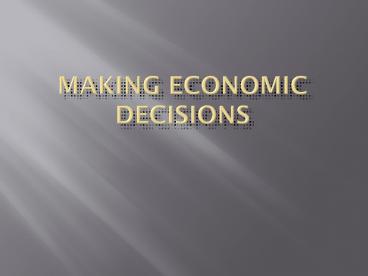MAKING ECONOMIC DECISIONS - PowerPoint PPT Presentation
1 / 10
Title:
MAKING ECONOMIC DECISIONS
Description:
Making economic decisions is simple. You are probably making economic decisions every day and you are not even aware of it. Scarcity forces people to choose how they ... – PowerPoint PPT presentation
Number of Views:206
Avg rating:3.0/5.0
Title: MAKING ECONOMIC DECISIONS
1
MAKING ECONOMIC DECISIONS
2
MAKING ECONOMIC DECISIONS
- Making economic decisions is simple. You are
probably making economic decisions every day and
you are not even aware of it.
3
MAKING ECONOMIC DECISIONS
- Scarcity forces people to choose how they will
use their resources. - Making economic decisions requires that we
consider all the cost and benefits before we make
a purchase. - Making economic decisions also requires that
people exchange one thing for another
(trade-off).
4
MAKING ECONOMIC DECISIONS
- A trade off is the alternative you face if you do
one thing over another. - If a country wants to do something like put more
money into education, then it must trade-off by
putting less money into something else like
building hospitals. - Nations and businesses are forced to make
trade-offs every day. Can you think of some on
your own?
5
OPPORTUNITY COST
- Opportunity cost is the cost of the next best use
of your time or money when you choose to do one
thing rather than another. - Opportunity cost involves more than just money.
It also includes all of the discomforts and
inconveniences that are linked to the choice
made. - Opportunity cost also includes the time you could
be spending doing other things such as listening
to music or visiting with your friends.
6
OTHER MEASURES OF COST
- Fixed cost are the expenses that are the same no
matter how many units are being produced.
Mortgage payments or property taxes are two
examples. - Variable cost are expenses that change with the
number of products being produced. - Total cost is determined by combining fixed cost
and total cost.
7
OTHER MEASURES OF COST
- Marginal cost is the cost of producing one
additional unit of output. - Marginal revenue is the additional revenue
received from producing one additional unit of
output. - Marginal benefit is the additional benefit gained
from producing one or more units of output.
8
COST-BENEFIT ANALYSIS
- A cost benefit analysis is done to determine
how well, or how poorly, a planned action will
turn out. Although a cost benefit analysis can be
used for almost anything, it is most commonly
done on financial questions. Since the cost
benefit analysis relies on the addition of
positive factors and the subtraction of negative
ones to determine a net result, it is also known
as running the numbers.
9
COST-BENEFIT ANALYSIS
- A cost benefit analysis finds, quantifies,
and adds all the positive factors. These are the
benefits. Then it identifies, quantifies, and
subtracts all the negatives, the costs. The
difference between the two indicates whether the
planned action is advisable. The real trick to
doing a cost benefit analysis well is making sure
you include all the costs and all the benefits
and properly quantify them.
10
Complete Ch. 18 Sec. 2 Assessment (1-7)

